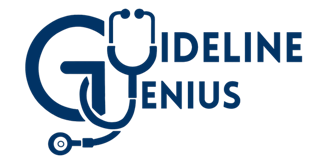Venous Thromboembolism (DVT and PE)
NICE guideline [NG158] Venous thromboembolic diseases: diagnosis, management and thrombophilia testing. Last updated: Aug 2023.
Background information
- Deep vein thrombosis: clot formation (thrombosis) within a deep vein; most commonly of the
- Pulmonary embolism: life threatening condition characterised by the presence of , usully arising from a DVT, in the pulmonary arterial system.
Provoked DVT/PE (~2/3 of cases): occuring in the presence of a recent (within 3 months) major clinical risk factor for VTE
Unprovoked DVT/PE (~1/3 of cases): occuring in the absence of a recent major clinical risk factor for VTE
Whether VTE is provoked/unprovoked plays a role in the duration of anticoagulation on NICE guidelines
- Common; VTE is the third most common cardiovascular disease (after acute myocardial infarction & stroke)
- VTE cases
- 1/3 → PE
- 2/3 → DVT
- Incidence increases sharply with age / presence of risk factors
- VTE cases
Virchow's triad encompasses the 3 major mechanisms that cause thrombosis
- Hypercoagulability
- Endothelial / vessel wall damage
- Venous stasis
Risk factors for DVT grouped by Virchow's triad
1. Hypercoagulability
- Personal / of VTE
- Active cancer
- Pregnancy /
- Hormone therapy (Combined oral contraceptive pill / Hormone replacement therapy )
- APS / thrombophilias (familial/acquired)
- Diabetes mellitus
- Smoking
- Male sex (particularly for DVT)
- Dehydration
2. Endothelial damage
- Recent trauma or lower limb fracture
- Surgery (direct vessel trauma) - esp major surgeries
- Direct venous trauma (e.g. IV cannula, indwelling central venous catheter)
- Recent myocardial infarction (< 3 months)
- Varicose veins / Superficial venous thrombosis
- Significant immobility / hospitalisation / bed rest >5 days
- Prolonged travel (> 4 hours)
- Heart failure
- (BMI >30)
- Increasing age (↑ incidence / mortality)
Other → causes of nonthrombotic embolism:
- Fat embolism
- Air embolism
- Amniotic fluid embolism
- Septic/Bacterial embolism
Symptoms
- Leg pain / tenderness
- Throbbing, cramping or dull ache
- Worse on walking/weight bearing
- Swelling (often calf or thigh)
- Feeling of tightness or heaviness
- Systemic features
- Low-grade fever, malaise
- If concurrent → symptoms of pulmonary embolism (e.g., dyspnoea, chest pain)
Signs / Examination Findings
- Leg swelling
- Calf-circumference
- Pitting oedema
- Erythema → redness, warmth or discoloration
- Dilated
- Local tenderness on palpation
- Special tests (less reliable, non-diagnostic but often mentioned)
- Homans sign → calf pain on foot dorsiflexion
- Meyer sign (calf-squeeze) → calf pain on compression
- Onset → typically sudden
- Dyspnoea → most common symptom (~50% of cases)
- Typically persistent or progressive
- ~40% of cases) OR retrosternal chest pain (less common)
- Cough ± haemoptysis
- Syncope or pre-syncope → more in massive PE
- Systemic features (fever, dizziness, weakness)
- Symptoms of DVT may be present
Signs / Examination findings
- General comments
- Signs / Examination findings are often nonspecific.
- Many patients have a normal physical examination (esp in smaller emboli)
- Potential findings
- Observations
- Tachypnoea / Tachycardia (common)
- Hypoxia
- Fever (low-grade typically)
- Hypotension / shock → suggests massive PE
- Right heart strain
- Elevated Jugular venous pressure
- Heart auscultation → loud P2, widely split S2
- Pleural rub
- Observations
- Pulmonary embolism
- Post-thrombotic syndrome (PTS) → up to 50% within 2 years of lower limb DVT
- Definition → chronic venous insufficiency in the affected limb,
- Clinical Dx → symptoms of chronic venous insufficiency (e.g., limp pain, swelling, oedema, skin hyperpigmenation), typically, 3-6 months after initial DVT event
- Acute
- Arrythmias
- Respiratory failure
- Right ventricular failure ± haemodynamic instability
- Sudden cardiac death (often due to Pulseless electrical activity
- Chronic
- Chronic thromboembolic pulmonary hypertension (CTEPH)
- Rare & severe complication (progresses to right heart failure)
- Subtype of pulmonary hypertension caused by chronic thromboembolic occlusion of pulmonary vessels
- Chronic thromboembolic pulmonary hypertension (CTEPH)
Deep Vein Thrombosis Guidelines
| Clinical feature | Points |
|---|---|
| Active cancer (or within 6 months) | 1 |
| Lower limb immobilisation (recent plaster use, paralysis, paresis) | 1 |
| Recently bedridden for ≥3 days or major surgery within 12 weeks requiring general or regional anaesthesia | 1 |
| Localised tenderness along the distribution of deep venous system | 1 |
| Entire leg swollen | 1 |
| Calf swelling >3 cm larger than the other leg | 1 |
| Pitting oedema confined to the affected leg | 1 |
| Collateral superficial veins (non-varicose) | 1 |
| Previously documented DVT | 1 |
| An alternative diagnosis is at least as likely as DVT | -2 |
Interpretation:
- Score 2 or more: DVT likely
- Score 1 or less: DVT unlikely
If the ultrasound cannot be done within 4 hours, perform the following:
- Perform D-dimer test, and
- Offer interim therapeutic anticoagulation, and
- Ensure ultrasound is done within 24 hours
Diagnose DVT and start treatment
Perform D-dimer test
- -ve D-dimer → DVT unlikely, consider alternative diagnosis (stop any interim anticoagulation)
- +ve D-dimer → repeat proximal leg vein ultrasound 6-8 days later
- Abnormal ultrasound → start treatment
- Normal ultrasound → consider alternative diagnosis
- -ve D-dimer → DVT unlikely, consider alternative diagnosis (stop any interim anticoagulation)
- +ve D-dimer → perform a proximal leg vein ultrasound (with results available within 4 hours)
- If ultrasound not possible → offer interim therapeutic anticoagulation and ensure ultrasound is done within 24 hours
If D-dimer cannot be done within 4 hours → offer interim therapeutic anticoagulation while waiting
The drug class of choice to treat DVT and PE are anticoagulants.
- Apixaban or rivaroxaban
2nd line:
- Warfarin with , or
- Dabigatran or edoxaban with
In renal impairment (not renal failure), apixaban is preferred over rivaroxaban as it has less renal excretion.
| Patient population | Recommended drug |
|---|---|
| Renal failure (creatinine clearance <15 mL/min) | Avoid Direct oral anticoagulant, use:
|
| Active cancer |
|
| Pregnancy | DOAC and warfarin are contraindicated, use:
|
| Anticoagulation contraindicated | Consider inferior vena cava filter |
| Antiphospholipid syndrome (triple positive) | Warfarin with LMWH lead-in |
- Provoked: 3 months
- Unprovoked: 6 months
- Concurrent cancer: 3-6 months
Pulmonary Embolism (PE) Guidelines
| Clinical feature | Points |
|---|---|
| Clinical features of DVT (minimum of leg swelling and pain with palpation of the deep veins) | 3 |
| An alternative diagnosis is less likely than PE | 3 |
| Heart rate >100 bpm | 1.5 |
| Immobilisation for >3 days or surgery in the previous 4 weeks | 1.5 |
| Previous DVT / PE | 1.5 |
| Haemoptysis | 1 |
| Active cancer (or within 6 months) | 1 |
Interpretation:
- Score 5 or more: PE likely
- Score 4 or less: PE unlikely
- Abnormal CTPA → diagnose PE and start treatment
- Normal CTPA
- If DVT is suspected → consider a proximal leg vein ultrasound scan
- If DVT is not suspected → PE unlikely, consider alternative diagnosis (stop any interim anticoagulation)
If CTPA is not appropriate (allergic to contrast / severe renal impairment - creatinine clearance <30 mL/min / high risk from irradiation)
- Consider V/Q SPECT or planar scan as an alternative
If CTPA / V/Q scan cannot be done immediately → offer interim therapeutic anticoagulation while awaiting CTPA
Bedside echocardiography to assess right ventricular strain is an appropriate alternative in those who are not suitable candidates for CTPA (e.g. clinically unstable for imaging, allergic to contrast, severe renal impairment, high risk from irradiation).
Note that this is not mentioned in NICE guidelines but is commonly performed in practice, and endorsed by international echocardiography guidelines.
- -ve D-dimer → PE unlikely, consider alternative diagnosis (stop any interim anticoagulation)
- +ve D-dimer → perform CTPA (or V/Q scan) immediately (i.e. follow the above PE likely algorithm)
If D-dimer cannot be done within 4 hours → offer interim therapeutic anticoagulation while waiting
Bedside echocardiography to assess right ventricular strain is an appropriate alternative in those who are not suitable candidates for CTPA (e.g. clinically unstable for imaging, allergic to contrast, severe renal impairment, high risk from irradiation).
Note that this is not mentioned in NICE guidelines but is commonly performed in practice, and endorsed by international echocardiography guidelines.
Offer:
- Continuous UFH infusion, and
- Consider thrombolytic therapy (e.g. alteplase)
The drug class of choice to treat DVT and PE are anticoagulants.
- Apixaban or rivaroxaban
2nd line:
- Warfarin with , or
- Dabigatran or edoxaban with
| Patient population | Recommended drug |
|---|---|
| Renal failure (creatinine clearance <15 mL/min) | Avoid Direct oral anticoagulant, use:
|
| Active cancer |
|
| Pregnancy | DOAC and warfarin are contraindicated, use:
|
| Anticoagulation contraindicated, or PE happened while on anticoagulation | Consider inferior vena cava filter |
| Antiphospholipid syndrome (triple positive) | Warfarin with LMWH lead in |
- Provoked: 3 months
- Unprovoked: 6 months
- Concurrent cancer: 3-6 months




